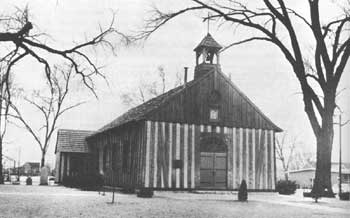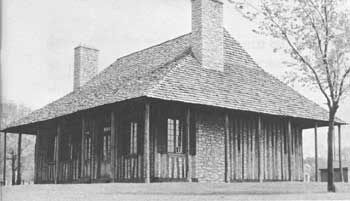






Survey of Historic Sites and Buildings
 |
CAHOKIA COURTHOUSE Illinois |
|
| ||
Capt. Jean Baptiste Saucier, the builder of Fort de Chartres, shortly after 1737 built this log-and-stone structure for his residence. It is a unique monument to the early French settlers of the Illinois country and an excellent example of French colonial architecture. The oldest house in Illinois, possibly the earliest surviving dwelling in the Midwest, and without doubt the oldest courthouse west of the Allegheny Mountains, it has been completely reconstructed.
 |
| Old Holy Family Church, Cahokia, Illinois, dates from about 1799. Restored in 1951, it is used regularly for religious services. (Courtesy, Evening and Sunday Journal, East St. Louis.) |
The construction is of special interest because of the vertical placement of the wall logs; the interstices contain stone and mortar. The building measures about 35 by 43 feet—unusually large—and consists of four rooms and a large attic. The builder's son sold it to the United States in 1793, after which it served as a U.S. courthouse and a center of political activity in the old Northwest. After the county seat was moved from Cahokia in 1814, it was used as a saloon, storehouse, public hall, and finally as a home again.
In 1904, the building was exhibited at the Louisiana Purchase Exposition in St. Louis, and was then purchased by the Chicago Historical Society. Part of it was exhibited in Jackson Park, Chicago, until 1938, when Illinois State archeologists excavated the original foundation site and discovered a number of objects relating to the building. In 1939, as part of a WPA program, the building was reerected on the original site, and much of the original material employed. The State of Illinois maintains the Cahokia Courthouse as a State memorial.
 |
| An excellent example of French colonial architecture, Cahokia Courthouse, Cahokia, Illinois, was originally a residence. Between 1793 and 1814, it served as a U.S. courthouse. |
 |
FORT KASKASKIA STATE PARK Illinois |
|
| ||
The area memorialized by this park has been under the flags of three nations: France, Great Britain, and the United States. Kaskaskia, established by the French in 1703, prospered as an important outpost on the Mississippi and a source of agricultural commodities. During the French and Indian War, the French erected a palisaded fort on the hill across the Kaskaskia River. Apparently it was never attacked, and the inhabitants destroyed it themselves after the Treaty of Paris in 1763, when the British assumed control of the Illinois country.
During the American War for Independence, George Rogers Clark captured Kaskaskia. From 1809 to 1818, the town served as the first capital of Illinois Territory. When Illinois became a State in 1818, it served as the capital for 2 years, but after 1820 began to decline. A disastrous Mississippi flood in 1844 destroyed most of the town, and in 1910 another flood completely obliterated the site.
Fort Kaskaskia State Park includes the home of Pierre Menard, built in 1802, which stands just below the hill on which the fort stood. The home is an excellent example of French colonial architecture. Nearby, close to the fort site, is the Garrison Hill Cemetery, which contains the remains of many early settlers. Some of the ramparts of Fort Kaskaskia are still visible, and on Kaskaskia Island the State of Illinois has erected a memorial to the pioneer French settlement.
 |
FORT MASSAC Illinois |
|
| ||
The original Fort Massac, named Fort Ascension, was erected in 1757 by the French to thwart British encroachment into the lower Ohio Valley. The following year, the French renamed it Fort Massiac. Cherokee Indians made the only known attack upon the fort, in the fall of 1757. At the end of the French and Indian War, when the French lost the area east of the Mississippi River to England, they abandoned the fort and it steadily declined. It was soon destroyed by the Cherokees, and the ruins were left untouched by the British.
In 1794, the United States rebuilt the fort to guard against Spanish attack and renamed it Fort Massac. After the War of 1812, it was abandoned. In 1903, when little more than the site remained, the Daughters of the American Revolution preserved part of the original site and made possible some reconstruction. The State of Illinois maintains the area now as a State memorial. Wood posts outline the first fort and its buildings, and a moat has been rebuilt.
 |
PÈRE MARQUETTE STATE PARK Illinois |
|
| ||
Père Marquette State Park, the largest in Illinois, commemorates the beginning of European exploration of the rich Illinois country and its subsequent settlement and development. The Illinois and Potawatomi Indians were occupying the area of the park when Père Marquette, along with Louis Jolliet and five other companions, passed by in the fall of 1673. At the confluence of the Illinois and Mississippi Rivers is located a large, plain cross in honor of Père Marquette's party. The park provides extensive accommodations for visitors, including a lodge and guesthouses, a nature museum, and interesting roadways.
 |
 |
http://www.cr.nps.gov/history/online_books/explorers-settlers/sitee9.htm
Last Updated: 22-Mar-2005